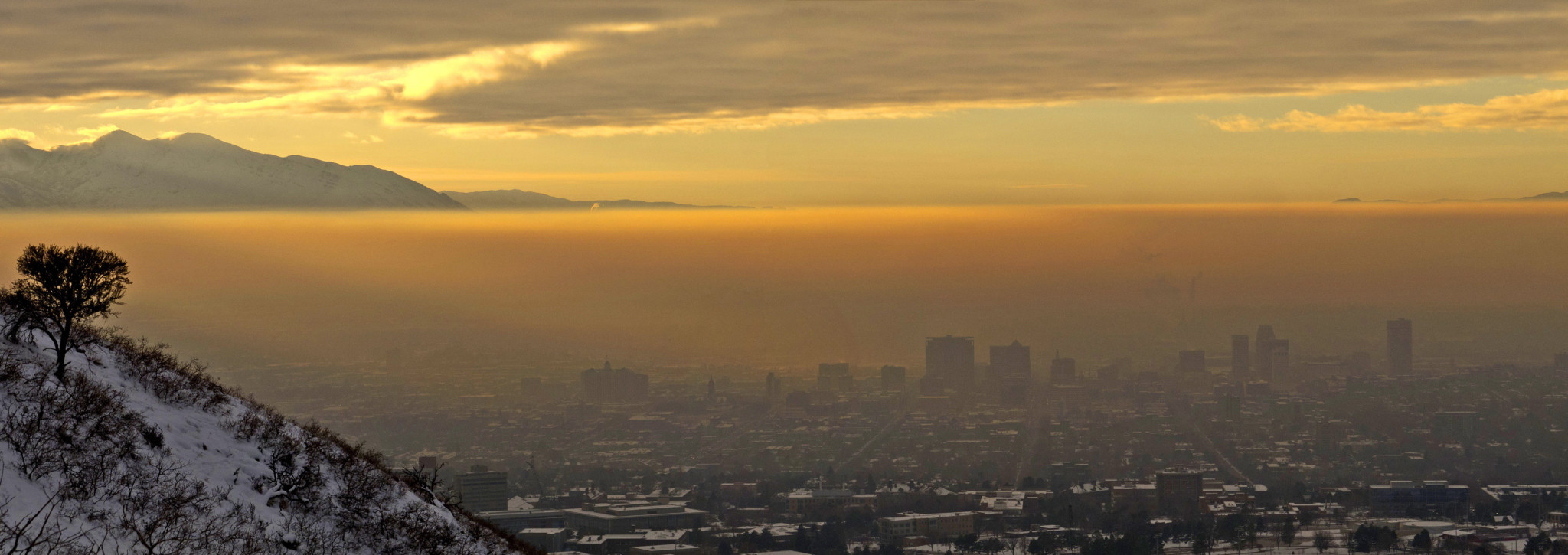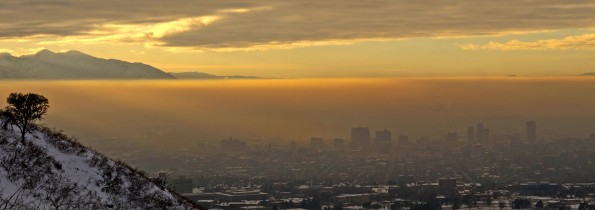Why It’s Red and Who Produces the Toxic Air We Breathe
The nasty brown air you and I are breathing gets a lot of press. Most stories are similarly written or produced: people talk about health issues; UTA crows about public transit benefits; and a Kennecott or oil refinery spokesperson describe their companies’ efforts to clean up facilities. Blah, blah blah.
As much as we are sick of the air quality, we are sick of this story. First of all, I don’t really care what the mayor or UTA spokesperson says. I don’t want to get out of my car on red air days. These are the days when I’m extremely glad I own a car, because my exposure to the cold and the bad air is minimized. Also, every car that goes through emissions testing has a catalytic converter. This device removes a great deal of the pollutants that cause us harm, such as carbon monoxide. So what is really making us sick? I literally have had a hard time breathing for the past few red air days. I’ve felt a burning in my throat. Our question: What is causing this?
Through our investigation, we have found that cars and commuters are far less to blame for the air that makes us sick. You don’t need to feel so guilty. Car exhaust is mostly CO₂ and water, but CO₂ is not the major culprit as it’s a naturally occurring compound in our atmosphere.
What is not okay to breathe are chemicals including chlorine, hydrochloric acid, ammonia, sulfuric acid, hydrofluoric acid, hydrogen cyanide, hexachlorobenzene and dioxin. These are the noxious chemicals that cause the burning in my throat. Cars don’t produce these nasties, industries do. Very likely you haven’t even heard of the industries that are the worst polluters making us sick. This is because that’s exactly what they want, to stay low on our radar.
US Magnesium, formerly known as MagCorp, is 27 miles east of Wendover in Rowley, Utah. It dumps almost nine million pounds of chlorine into our atmosphere every year. So is chlorine gas bad for us? “When chlorine enters the body as a result of breathing, swallowing, or skin contact, it reacts with water to produce acids. The acids are corrosive and damage cells in the body on contact,” according to the U.S. Health Department.
So if, like me, you are feeling more acid in your throat, you can thank the chlorine being dumped into our Wasatch Front in higher volumes than any other place in the United States. Thank US Magnesium as well for making it hard to swallow. So why is it allowed to continue?
This Tooele county facility has been severely punished for its environmental record. In the early 1990s a federal lawsuit was filed against then MagCorp which sought $1 billion for infractions. At that time, 90 percent of all the chlorine emitted into the atmosphere nationwide was coming from MagCorp. Rather than pay the fines, it declared bankruptcy. Magcorp was then bought by US Magnesium, which has reduced emissions.
Incredibly, in 1989, MagCorp was annually dumping a whopping 119 million pounds into the atmosphere. Since acquired by Renco, they have reduced emissions to nine million pounds today. US Magnesium’s website claims it is, “developing methods to positively impact the environment.” But it’s hard to consider dumping chlorine into our air as “help” when we consider the harm it causes those of us who happen to breathe.
US Magnesium is currently listed on the Environmental Protection Agency’s website as a location eligible to become a “superfund site,” but for some reason progress is moving extremely slow. A toxicological report filed in 2007 has not resulted in an injunction against its current harmful activities and terrible working conditions.
The 2007 report filed for the U. S. Department of Justice by University of Colorado PhD Richard L. DeGrandchamp states that not only does it have 12 areas around the facility that will require cleanup, but also, “Many peer-reviewed studies showing that family members exposed to workplace contamination have manifest toxic symptoms, and some have died.”
This is the result of harmful exposure to dioxin, a chemical that is also released by the plant. According to Dr. DeGrandchamp’s report, unlike chlorine which has a greenish hue as a gas and a distinct smell, “exposures to dioxins and HCB are insidious and go completely unnoticed. Furthermore, while physical symptoms of chlorine gas exposure appear immediately, exposure to dioxin and HCB can go completely unnoticed until cancer develops, which can be more than 10 years after the initial exposure.”
US Magnesium is owned by the Renco Group, a New York-based holding company, which owns some of the largest industrial polluters in the world including facilities in Herculaneum, Missouri, where it releases excessive levels of lead and arsenic. It also owns a La Oroya, Peru mine where it has made that city, “the worst polluted place in the world” according to the Blacksmith Institute.
To convolute responsibility further, Renco is owned by Inteva Products, LLC. Renco boasts revenue of over $5 billion annually. Since 1975 it has acquired 40 troubled companies. Many, like MagCorp, had realized difficulties after their environmental abuse and many are responsible for the mining and extraction of metals.
Magnesium is used in products for flavors and fragrances. It’s used to produce pharmaceuticals. Magnesium is used to as an alloy with aluminum to make all of our beverage containers. So of course Mag Corp. is a very useful company producing a very useful product, but on inversion days, they are also producing toxins in our atmosphere.
While Renco has invested $50 million in cleaning up the nation’s largest magnesium production facility here in Utah, operations should at the very least be turned off when we have red air inversions. But this won’t happen because, despite the damning report filed by Dr. DeGrandchamp, a federal judge has thrown out the case against Renco.
Further research is required to understand how one company can own so many places around the world that produce such toxic air and waste as Renco? How has it been able to skirt a pending lawsuit from the EPA for almost eight years? We encourage readers to examine the report produced in 2007. We have not been able to reach US Magnesium for an official statement, but there has been no press release stating that anything has been done about the infractions stated in the 2007 report.
For our sources, please visit:
https://utahstories.com/2013/12/notes-and-sources-for-worst-polluters-in-utah/
https://utahstories.com/2014/01/worst-wasatch-front-polluters/







